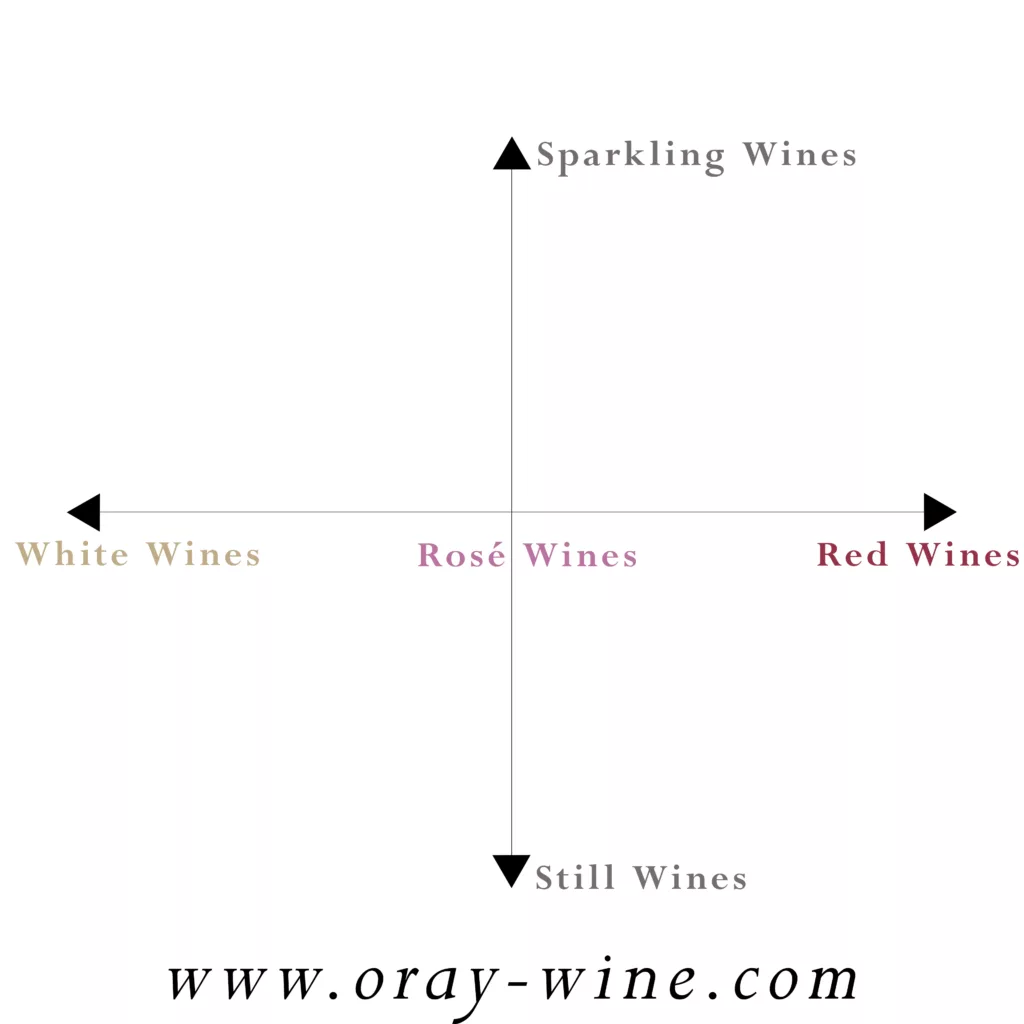There are several ways to answer this question about the different types of wine. The easiest answer would be to use several segments to cover a very wide spectrum of all the different wines in the world. Below are the different segments that I am suggesting to help wine novices get a better grasp on the world of wine:
- The color
- Still/ Sparkling
- The Sugar Content
- The way the wines have been made
- The grape varieties used
- The place / region of origin
The Color
There are only three main wine colors: red, white, and rosé. We can even reduce it to two colors (white and red) if we consider the rosé color a variation of the red. However, for a better understanding, it is important to keep these 3 colors in mind and consider that all the wines fall within these 3 categories. You will find wine described as “salmon,” “grey,” and other colors, but these are just variations of the rosé colors. The same is true for the white wines, you may find adjectives like amber, orange, … As for the reds, it is more obvious, as the describing adjectives can range from almost deep dark to purple, ruby, and garnet, but they are somehow more obvious to attribute to red wines.
The color attribute derives mainly from the color of the skin of the grapes used to make the wines. The grapes are only two colors: dark (red) and white (yellow). We say mainly because rosé can be made using different techniques using either a mix of white and red grapes or a very short time of skin contact related to pressing red grapes. And white can be made from both types of grapes, either white or red (so long as you do not leave the black skins in contact with the juice after pressing).

The Still / Sparkling
The separation is more obvious. If you have any kind of bubbles within your glass it is a sparkling wine. It groups the different sparklings such as Champagne, Crémants, Petillants Naturels…
This segmentation is to be combined with the color segmentation to cover most types of wines. Lambrusco wines are red sparkling whereas Champagne houses produces prestigious Rosé Champagnes and White Champagnes (either from red or white grapes).

If you combine these 2 segments color + still/sparkling, you will be able to cover almost any kind of wines around the world. But, if you want to be more precise in your understanding of this new world, you can add the final level of sugar and the technique used to make the wines.
For the final level of sugar, there is a very wide spectrum of wines covered very dry (almost no residual sugar, meaning that almost all the sugar for the grapes have been converted into alcohol during the fermentation) to very sweet (when winemakers use different techniques to raise the level of sugar into the grapes and/or do not ferment all the sugar) like Late Harvest wines (such as some Gewurtzraminer in Alsace, France), Ice Wines (where grapes have been left in the cold to freeze which reduce the level of water once unfrozen) and botritized wines such as Sauternes (in Bordeaux) and Ruster Ausbruch (in Austria).
The Technique used
Regarding the technique used, for simplification purpose, let’s just talk about the fortified/unfortified wines. Fortified wines are usually made by adding a grape spirit during the alcoholic fermentation to stop it. It results in higher final alcoholic level which gives the wine a better capacity to be aged and transported without spoilage risk. The color segmentation is applicable on top of it (except for rosé, as there are no fortified rosés) as there are red fortified and white fortified with a wide spectrum of colors derived for these two (Ambré, Tuilé, Tawny…). The most famous fortified wine is probably a red wine in the name of Port.
The Grape used
The most renowned grapes worldwide, such as Pinot Noir, Merlot, etc., are in fact sub-families and express different aromas. They are the main grape’s genetic evolution to better adapt to location conditions. For instance, Pinot Noir is wholly responsible for the most prestigious red Burgundy wines. It is a local adaptation of the Noirien grape family, whereas Pinot Nero is more of a Burgundy Pinot Noir adaptation to some Italian terroirs.
The Place / Region of origin
This is more obvious but very important in the world of wine. The location criterion is tightly tied to the notion of Terroir (read more about Terroir here), which is the backbone of the aromatic expression of the grapes that translates into the wine. Let’s consider very famous grapes like Chardonnay or Cabernet-Sauvignon, it is easily understandable that they will not exhibit the same aromas if they are grown in a desert location or near the ocean.

Follow me on my Social Media
Wine is a gourmet treasure, do not abuse alcohol!
None of this content has been sponsored
I did not receive any gifts or free samples that could be related to this article